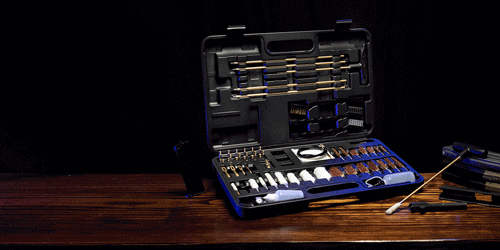Hunting Whitetail Deer in the Rain
Hunting whitetail deer in the rain presents unique challenges but can offer great opportunities. While wet conditions might deter some hunters, savvy ones know that rainy weather can provide advantages, such as quieter movement and heightened deer activity. In this guide, we'll explore strategies and tips to help you successfully hunt whitetail deer in the rain.

Why Hunt Whitetail Deer in the Rain?
Generally, rain has little effect on whitetail deer unless it's a heavy downpour. In those cases, all wildlife activity, including that of deer, tends to pause until the storm passes. However, during light rain or a steady drizzle, deer typically continue their normal routines, almost as if it were a clear day. The challenge is that what feels like 'light' rain to a deer can seem like a soaking to a hunter, who may be more concerned about keeping gear dry, staying warm, and avoiding getting sick.

Rain can change deer behavior in ways that can benefit hunters. Here are a few reasons why you should consider hunting during wet weather:
- Reduced Scent Spread: Rain is often believed to help suppress human scent, making it more difficult for deer to detect your presence. The idea is that the moisture washes away scent particles and prevents odors from lingering in the air. However, opinions vary on this point, and there's no definitive scientific evidence to confirm it. While many hunters have observed this effect in the field, it ultimately comes down to personal experience and how weather conditions impact each hunt.
- Quieter Movement: Rain softens the ground, making it easier for hunters to move quietly through the woods. Deer also move more silently, so you must remain alert.
- Increased Daytime Activity: Whitetail deer tend to move more during daylight hours when it rains, particularly during light to moderate rainfall. Overcast skies make them feel safer, so they may feed or move more often during shooting light.
During hunting season, rain typically doesn't affect deer movement. In my experience, whitetails don't alter their routines just because of rain. They still head to the field daily, except in extreme conditions like intense heat, strong winds, or heavy downpours. Otherwise—whether it’s a drizzle, light rain, or even heavier rainfall—they appear right on schedule: does and fawns come out first, followed by smaller bucks, and finally, near dusk, the big mature bucks I’m after.
Wear the Right Gear
Avoid bringing electronic gear unless you're okay with the risk of moisture damage. Leave behind your wallet, keys, pocket knives, extra flashlight, and GPS. Skip the pack and avoid bringing cameras, cooking equipment, tripods, rangefinders, space blankets, survival gear, or anything else that rain could ruin. Treat your rainy day hunt as a minimalist adventure—bring only the essential gear you need to successfully bag and tag your buck.
Tactical Poncho for Wet Weather
A high-quality tactical poncho is essential for staying dry while maintaining mobility. Look for a lightweight, waterproof, and breathable poncho that doesn’t restrict movement. Bonus points if it has camo patterns to blend with your environment.

Waterproof Boots
The last thing you want is wet feet. Invest in sturdy waterproof boots with good traction to prevent slipping on wet, muddy terrain.
Waterproof Notebook
Keep a waterproof notebook handy to jot down notes about deer movement, trail signs, and changes in weather conditions without worrying about the pages getting wet.

Sharp Knife
A sharp knife is indispensable for field dressing and cleaning your game efficiently. With a sharp knife, you don’t have to apply as much force to make cuts, reducing the likelihood of slipping and causing an accidental injury.
A Bottle of Water
A bottle of water is essential for staying hydrated during a hunt, maintaining your focus and energy levels, and preventing fatigue.
Climbing Stand
A climbing stand helps hunters by providing elevated vantage points, improving visibility, and reducing scent detection by keeping you above a deer's line of sight and smell. It also offers mobility, allowing you to quickly change locations for better hunting opportunities.
Choose the Right Hunting Spot
Rain can change the dynamics of where and how deer move. Here are some tips for selecting your hunting location:
- Seek High Ground: Deer will often move to higher ground during heavy rain to avoid getting waterlogged. Set up your stand or blind near ridgelines or slightly elevated areas.
- Target Food Sources: Rain tends to make deer feel secure enough to leave cover and move to feeding areas, especially during light rain. Focus on food plots or fields where deer commonly feed.
- Locate Thick Cover: During heavy downpours, deer prefer to bed down in thick brush or dense cover. If the rain intensifies, adjust your strategy to hunt near bedding areas where deer may seek shelter.

Adjust Your Hunting Strategy
Rain affects deer senses and movements, so you’ll need to adjust your strategy accordingly:
- Slow Down: Take advantage of the quiet environment. Move slowly and cautiously to avoid detection. The softer ground helps reduce noise, but you still need to stay alert.
- Use Deer Calls: The rain can dampen ambient sounds, including natural noises that deer make. Using deer calls to grab their attention can help you bring them in from a distance.
- Be Patient: Rain can make deer unpredictable. If you’ve chosen a good location, remain patient, and wait for them to move into view. Whitetail deer may be more active before or after a storm passes, so keep hunting even if the rain lets up.
- Be There: Deer tend to stay active all day during steady rain, especially if the wet weather continues for several days. Don’t let the rain discourage you—the deer still need to eat and socialize, particularly during the rut. Make sure you're out there with them! Also rainy weather doesn't fundamentally change deer behavior. Instead, they tend to be more active during the day and adjust their morning and evening routines to compensate for the reduced daylight. With less light, deer feel safer and more at ease, allowing them to roam more freely.

- Plan All-Day: Key areas to target in steady rain include the trails, runs, and feeding spots you scouted before the season. Arrive early and plan to spend several hours in each location. If you need to move, do so around midday when deer are usually less active. While you could encounter a whitetail at any time, those typical pre-dusk deer will start moving much earlier in rainy conditions. Get set up by 1:30 p.m. and stay until dark, as mature bucks may wait until the last moment to move—and on rainy days, that moment may come 15 minutes or more before sunset.
- Facing more Challenges:Rainy-day hunting is a double-edged sword. While the conditions can be ideal for stalking deer, they also present a unique set of challenges. The woods can be a noisy and chaotic place when it's raining, with the sound of falling raindrops creating a deafening din that can mask the subtle sounds of approaching deer. Meanwhile, the wet leaves and debris on the forest floor allow deer to move silently, making them even more elusive. As a hunter, you'll need to be hyper-vigilant, constantly scanning your surroundings for any sign of movement. But be warned: a wet deer can be almost indistinguishable from the surrounding foliage. It's easy to miss your chance if you're not paying attention.
- Less Other Hunters:Rainy days offer a unique opportunity to hunt those coveted spots that are usually crowded with hunters on sunny days. With fewer vehicles parked along the woods roads, you'll have your pick of prime locations, as many hunters opt to stay warm and dry back at camp. This means you can stake out those hotspots that are normally overrun with competition, giving you a better chance of bagging a trophy.

- Difficult on Tracking: The only significant drawback to hunting in the rain is the challenge of tracking wounded game. To minimize the risk of losing a deer, it's crucial to carefully assess your shooting lanes and make precise shots. Aim to take clean, close-range shots that result in a quick and humane kill. Avoid taking iffy shots or pushing your luck at long range, as a poor shot can lead to a lost deer. Rain-soaked blood is difficult to spot, and a steady downpour will rapidly erase any sign of a hit, making it nearly impossible to track your quarry. If you don't recover your deer immediately, the chances of finding it the next morning are slim, as the rain will have washed away all evidence of the shot.
The most effective shot placement is directly behind the shoulder, in the center of the deer's body. A well-placed bullet or broadhead in this location will result in a quick and humane kill. Additionally, the rain can actually work in your favor when shooting with a bow. The sound of the rain can mask the noise of the bow's release, making it less likely to spook the deer, and the arrow will often pass through the animal without being noticed, allowing for a clean and quiet kill.
Stay Comfortable and Safe
Hunting in the rain can be uncomfortable if you’re not prepared. Here are some tips for staying comfortable and safe:
- Stay Warm: Rain often brings cooler temperatures, so layer your clothing to stay warm and dry. Use moisture-wicking base layers to keep sweat off your skin, and top it off with your waterproof outer layers.
- Watch for Slippery Terrain: Wet ground can be slippery, especially in wooded areas. Be cautious when climbing stands or walking on steep trails. Always prioritize safety by wearing proper footwear and taking your time to avoid falls.

Conclusion
Hunting whitetail deer in the rain offers unique challenges and rewards. By wearing the right gear, adjusting your strategy, and paying attention to deer behavior, you can turn a rainy day into a successful hunt.
Rain or shine, whitetail deer hunting can be a thrilling adventure—and with the right preparation, you’ll be ready for whatever nature throws your way. Happy hunting!





